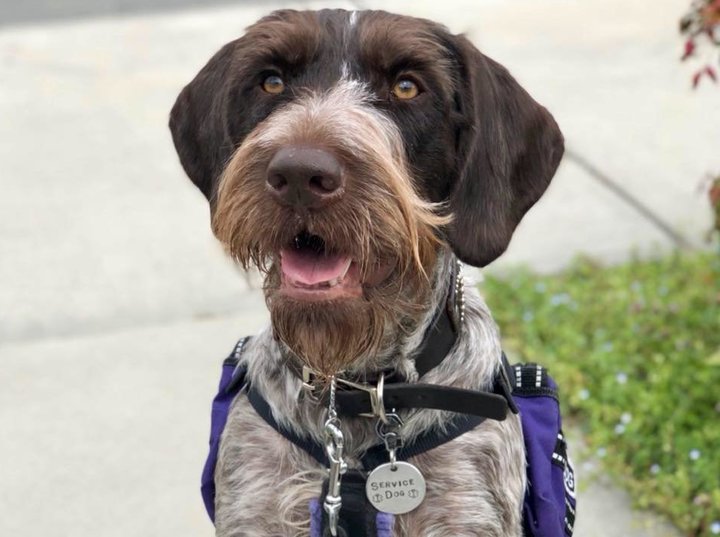5 things everyone should know about service dogs in US
Yes, they’re cute. But they also have a job to do.
Many kids learn it’s important not to touch service dogs. But many families don’t teach kids anything else about these animals or the many ways they can help humans.
We talked to people who train animals to assist others, as well as people who rely on them every day, about the lack of information and awareness involving service dogs. Here are five important things they want everyone to know.

Ariel Wolf has a service dog named Jubilee, a German wirehaired pointer she trained herself (source: Hufflington Post)
Service animals aren’t the same as therapy animals or emotional support animals.
The Americans with Disabilities Act defines service animals as “dogs that are inpidually trained to do work or perform tasks for people with disabilities.” (Miniature horses are covered under a separate provision; we’re highlighting service dogs because they’re more common.)
Every service dog is a bit different when it comes to its training and its handler’s needs, said Jennifer Boan, the annual fund and communications manager for Paws With a Cause , a nonprofit organization that trains service dogs. For example, her organization provides its clients with a personal alarm that dogs can set off in case of an emergency, but other service dogs may not have a similar tool.
Therapy animals and emotional support animals don’t have rights under the ADA, and can come in a variety of species. Parrots, pot-bellied pigs, llamas and rats are among the nine species registered by Pet Partners, an organization dedicated to improving lives through therapy animals. Such animals generally offer companionship in places like children’s hospitals, nursing homes and centers for veterans affairs, while emotional support animals help with emotional well-being and can help with conditions such as anxiety and depression.
Never distract a service dog.
Ishanti Holmes said people sometimes attempt to interact with Kaydet, the Harlequin Great Dane she has had since last year. If the dog obliges, they say, “Well, she’s not a real service dog.”
“Dogs aren’t robots,” said Holmes, who was diagnosed with multiple sclerosis when she was in the military. “They’re not perfect, so if you’re going to look at the dog and talk to the dog, that dog is going to try to go to you for comfort.”
Even service dogs ― like Kaydet, who is there for mobility assistance and helps Holmes with her post-traumatic stress disorder ― have “off days,” she said.
Ariel Wolf has a service dog named Jubilee, a German wirehaired pointer she trained herself. Jubilee helps with mobility assistance due to Wolf’s genetic condition that affects her connective tissue. Like Holmes, Wolf has met people who won’t respect her wishes when she asks them not to pet her working service animal.
“The response I often get is, ‘I just couldn’t help myself,’” Wolf said.
Boan from Paws With a Cause pointed out that outside attention can keep a service animal from focusing on its handler.
“When people interact with the dog and talk to them and make eye contact, the dog is looking for that interaction in public,” she said, “and then the dog might solicit the attention rather than focusing on the client.”
Service animals don’t need a certificate to work.
Some people may ask for documentation if a service dog enters their property. But under the ADA, an institution’s employees can ask only two things: “Is the dog a service animal required because of a disability?” and “What work or task has the dog been trained to perform?” Asking for documentation for the dog or asking about the person’s disability is not allowed.
In fact, ADA does not require service animals to have documentation. (Local animal licensing, vaccinations and other policies do apply, though.)
“There are inpiduals and organizations that sell service animal certification or registration documents online,” the ADA says on its frequently asked questions list. “These documents do not convey any rights under the ADA and the Department of Justice does not recognize them as proof that the dog is a service animal.”
To avoid conflict, some people carry a card or other paperwork just in case they’re questioned about their animal. Wolf said Jubilee has business cards that have information about the ADA printed on the back and answer the two questions allowed under the act.
Service dogs (and the people they help) are not here for your entertainment.
Holmes said people don’t always take it well when she asks them not to photograph her dog.
“I’ve learned to be very patient,” she said. “I’ve put myself in other people’s shoes, and I understand because I’ve been on the other end of this before, but we’re not here for people’s entertainment. I’ve had people get upset because I wouldn’t let Kaydet take a picture with a little girl. The parent kind of scoffed, trying to make me feel bad about it.”
Wolf knows Jubilee can attract attention. She constantly wags her tail and is a breed not commonly seen as a service dog. Still, Wolf said she wished people would respect her space more. She said people have interrupted her while eating dinner with loved ones to ask about Jubilee.
 |
Ariel Wolf has a service dog named Jubilee, a German wirehaired pointer she trained herself (source: Facebook)
“I understand there are many dog lovers out there who have a question about her or her job, as I, too, am a dog lover,” she said. “I usually don’t mind answering questions, even if that same burning question is one I’ve heard already a number of times that day. What I’m not a fan of is being treated like I’m not deserving of my own time and space because I have a service dog.
Wolf encouraged people to use common sense, practice self-control and treat a service dog as “an extension of their handler.”
“If you wouldn’t ask a random stranger about their personal medical history, don’t ask a service dog handler,” she said. “If you wouldn’t take a picture of a stranger or hug them without asking permission, respond accordingly with a service dog.”
Many handlers will go out of their way to make sure others are comfortable.
Some people are afraid of dogs, and some are allergic. That’s why Wolf keeps Jubilee neatly groomed and is constantly aware of others around her.
“A few months ago a young boy hid fearfully behind his father after seeing Jubilee,” she said. “I commanded her to cross behind my back, lay down, and put her chin on the floor. There wasn’t any good way to go around him, but I wanted the boy and his father to know Jubilee was under my control and to make her appear as nonthreatening as possible. I think this is respectful, and it would be selfish to presume my needs are greater or more deserving than those of anyone else.”
Regardless of whether a handler takes this extra step, it’s important to pay attention to the body language of any animal ― pets, service animals and therapy animals alike ― and act accordingly.
“As humans, we are not really good at reading animal body language,” said Mary Margaret Callahan, senior national director of programs at Pet Partners. “We’re so used to communicating verbally. When it comes to animals who can’t talk, we aren’t as attentive as we should be. I think that we can all be better partners to any animal in the world by trying to pay more attention to their body language./.
VNF/The Hufflington Post
Recommended
 Handbook
Handbook
Vietnam Moves Up 8 Places In World Happiness Index
 Handbook
Handbook
Travelling Vietnam Through French Artist's Children Book
 Multimedia
Multimedia
Vietnamese Turmeric Fish among Best Asian Dishes: TasteAtlas
 Handbook
Handbook
From Lost to Found: German Tourist Thanks Vietnamese Police for Returning His Bag
Popular article
 Handbook
Handbook
Prediction and Resolution for the Disasters of Humanity
 Handbook
Handbook
16 French Films To Be Shown For Free During Tet Holiday In Vietnam
 Handbook
Handbook
Unique Cultural and Religious Activities to Welcome Year of the Snake
 Handbook
Handbook



